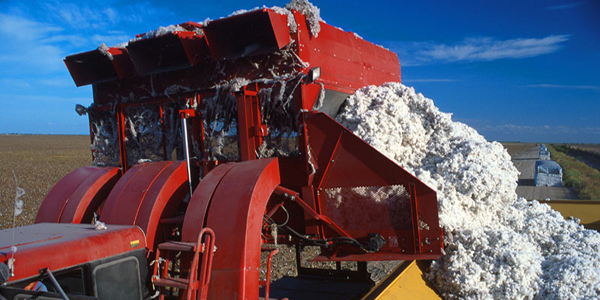- Washington “follows with interest” Morocco’s openness onto Africa (John Kerry)Posted 11 years ago
- The trial of South African Paralympic champion Oscar Pistorius opened in Pretoria on Monday.Posted 11 years ago
- USA welcomes efforts of King Mohammed VI in MaliPosted 11 years ago
- Egypt’s population reaches 94 millionPosted 11 years ago
- Mugabe celebrates his 90thPosted 11 years ago
- Moroccan Monarch to Build a Perinatal Clinic in BamakoPosted 11 years ago
- King Mohammed VI handed a donation of bovine semen for the benefit of Malian breeders.Posted 11 years ago
- Moroccan King’s strategic tour to Africa: Strengthening the will of pan African Solidarity and stimulating the south-south cooperation mechanisms over the continentPosted 12 years ago
- Senior al-Qaida leader killed in AlgeriaPosted 12 years ago
- Libya: The trial of former Prime Minister al-Baghdadi AliPosted 12 years ago
West Africa: The Cotton re-emergence
 On the 1965 to 1985 period, the West African countries saw the birth and development of textile industry, thanks to their proactive policies, that started in the 1950s with the first industrial units being established. Time went out and difficult years have followed, marked by the crisis of public enterprises, the structural adjustments, the devaluation of the CFA franc and import of second hand clothes from developed countries and Asian textiles.
On the 1965 to 1985 period, the West African countries saw the birth and development of textile industry, thanks to their proactive policies, that started in the 1950s with the first industrial units being established. Time went out and difficult years have followed, marked by the crisis of public enterprises, the structural adjustments, the devaluation of the CFA franc and import of second hand clothes from developed countries and Asian textiles.
Here began the process of de-industrialisation in the UEMOA zone, which has had about 41 industrial units in 1980, against twenty in operation today. Six years ago, the cotton farmers in Mali, Burkina Faso, Benin, Ivory Coast, Senegal and Chad were producing globally 1.1 million tons of fibber. But the West African cotton sector went through a crisis, and all members of the least developed countries bloc have been lobbying the World Trade Organisation for the removal of trade-distorting subsidies they say triggered a slump in cotton prices during the early 2000s. This is to be added to the impact of the Euro and dollar on the CFA parity. All this has halved the annual harvest, and farmers have been forced to abandon this culture. However, the situation is very different between the Francophone countries, exporting the 90% of the cotton production, and English-speaking countries, like Nigeria and Ghana, where respectively 90% and 65% of cotton was indeed consumed locally by the industrial fabric, over the period 1993 to 2004. By launching, in 2003, the cotton-textile development strategy, the Least Developed Countries bloc ambition was to develop a regional textile industry and transform at least 25% of local cotton production per year by 2010, with the promotion of a regional trade policy consistent with this industrial strategy, because the fabric and clothing is the traditional second-largest activity employer in West Africa, after agriculture. Up to 70% of the Malian craftsmen, 50% of the Burkina Faso artisans, and 30 to 40% of the Ghanaian artisans are working in the textile tradition. The ultimate objective is to safeguard this important industry that employs more than 10 million people in the UEMOA. That is why the cotton companies should adopt without delay, good practices imposed by challenges of the quality and the competitiveness in the products, enabling the industry to take advantage of changes in the market prices. Cotton prices reached, in October, their highest level for the last 140 years on the New York commodities exchange. For delivery in December, the cotton was worth almost a 1.20 US dollar, and the African producers are hoping to replenish their supply chains, and the cotton’s professionals had not indeed witnessed a price rise. In one month, the rise was of 30%, and over the past twelve months, the increase was of 75%. This surge was due to the lower world stocks, itself a consequence of a strong Chinese demand, which recorded crop failure, just as India and Pakistan. This situation is making the West African cotton growers to predict on big increases in output this year on the back of improved profitability. But experts believe it will take several years to replenish the accounts. Most of cotton companies have sold their crops in advance, before this highest historical level of price is reached. For the farmers, too, it will take several months before pocketing some profits of the increase, because the purchase prices are indeed set in advance on the basis of an annual average. Therefore, the results obtained in implementing various programs to boost the cotton sector remain below expectations. Thus and in regard to the important role this sector is playing in the socio-economic development, the West African Economic And Monetary Union (WAEMU) and their partners have decided to revive the cotton sector. To do this, they have met in the Burkinabe capital with the ultimate goal of rehabilitating all the cotton competitiveness so that it continues to contribute to the socio-economic role in terms of jobs, maintaining the social fabric and reducing poverty. But also to enhance the sustainability of this African cotton production that consumes very little carbon and chemical inputs, compared to the American, European or Chinese cotton. However, a real, longer-term recovery will require the broader adoption of agricultural technologies that would increase yields, and also the successful navigation of some tricky management and infrastructure issues.
